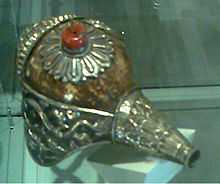Dung-Dkar

Dung-Dkar (Tibetan: དུང་དཀར་
[tʰúŋkar]) translated from Tibetan is literally “white conch” (Tibetan-English Dharma Dictionary, 2003), and true to its name, it is a trumpet formed from a white conch shell of the species Turbinella pyrum, from the Indian Ocean. (It is also known as the “śaṅkha”, the Sanskrit word for the same shell). It is heavily decorated with ornate patterns in metals such as silver, bronze or tin and is topped with a bright bead, which is said to represent good energy.
India
Throughout Indian history, the conch shell or shankha was a symbol of great power, authority and sovereignty. A conch is one of the Ashtamangala, the eight auspicious objects. Each mythological hero in ancient Indian epics is described as having a great white conch shell, which usually has a name. When the hero sounds his conch (used as a trumpet or more accurately a bugle) it invokes terror in his opposing forces and symbolises the start of a battle. It is this ancient belief that is thought to have influenced the image of the white conch in Tibetan religious music, where the conch is a sacred symbol of peace and good energy.
Tibet
The dung-dkar has been used as an instrument throughout all the recorded history of religious music in Tibet. Before Buddhism was introduced to the region, the Tibetan religion was the shamanistic “Bon”, and in that context the dung-dkar was used to invoke and call the spirits to help grow cattle or food plants and even to banish evil spirits that caused illness and destruction. Nowadays the dung-dkar is mainly found only in Buddhist monasteries and performances, and is very rarely used as a secular instrument.
Hornbostel-Sachs classification
The Dung-Dkar is an aerophone that produces its sound much like a trumpet, in that vibration is passed on from the player’s lips to the instrument itself. It can be described by the Hornbostel-Sachs classification number 423.111.2. This can be broken down into these sections (Grove Music Online Aerophone: Appendix, 1914):
- 4 – Aerophones: the air itself is the vibrator in the primary sense …
- 42 – Wind instruments proper: the vibrating air is confined within the instrument itself …
- 423 – Trumpets: the airstream passes through the player’s vibrating lips, so gaining intermittent access to the air column which is to be made to vibrate …
- 423.1 – Natural trumpets: without extra devices to alter pitch …
- 423.11 – Conches: a conch shell serves as trumpet …
- 423.111 – End-blown …
- 423.111.2 – With mouthpiece …
Notation and range
The Dung-Dkar can be considered a form of bugle, so is limited to a single harmonic series. There is no real set tuning because the instrument is formed from a primarily naturally-grown object it has many different variables including size, shape and texture. These affect the tone, pitch and playability of the Dung-Dkar (obviously smaller ones play higher notes more naturally and the larger ones play lower notes easier).
That being said, the notation for the Dung-Dkar – used only sparsely in certain Buddhist monasteries – is much like the notation used for chants. The notation used for chants contains very little (if any) pitch information and only mainly rhythmic and pronunciation. For this, the notation uses a system of neumes -not unlike some of the earliest music notation of medieval Europe – that contain rhythmic and melodic contour information, rather than actual pitch information. However, the Dung-Dkar plays different pitches only in exceptionally rare circumstances, and is used only for decoration in Tibetan ensembles.
Role within music
The sound of the Dung-Dkar is a “symbol of the proclamation to the world of Buddhist law” (Grove Music Online, 2006) and is played in pairs in orchestras or to summon the public to certain ceremonies. If the Dung-Dkar is used for summoning, the players will play the instruments from the top of monasteries facing towards each of the four points of the compass in turn.
An example of the dung-dkar being used in an ensemble situation is a traditional offering to Buddha, where the instrument is accompanied by the “sil-snyan” (small cymbals) and the “mchod-rnga” (offering drum). The sound of the ensemble is said to make the ghosts panic and Buddha happy. The playing of the dung-dkar is often left to young boys who will later learn how to play other instruments of Tibetan Buddhism.
References
- Anthology of World Music: The Music of Tibetan Buddhism. [Booklet notes by Peter Crossley-Holland.] [CD] Massachusetts: Rounder Select
- arts, Central Asian. (2006). Encyclopædia Britannica Online. Retrieved April 10, 2006 from http://wwwa.britannica.com/eb/article?tocId=82600
- Canzio, R., Dhondup, T., Helffer, M., Henrion-Dourcy, I.., Luzi, L., Pegg, C., et al. Tibetan Music. Grove Music Online. Retrieved 10 April 2006 from http://www.grovemusic.com/
- Ellingson, T. (1979). The Mandala of Sound: Concepts and Sound Structures in Tibetan Ritual Music. Ann Arbor, Michigan: UMI
- Hornbostel and Sachs (1914). Aerophone: Appendix. Grove Music Online. Retrieved 10 April 2006 from http://www.grovemusic.com
- Kumar, N (2004). The Conch Shell. Retrieved 11 April 2006 from http://www.religionfacts.com/buddhism/symbols/conch.htm
- Marcuse, S. (1975). Musical Instruments: A Comprehensive Dictionary. New York: Norton
- Miller, R. Music of Tibetan Buddhism. Retrieved 11 April 2006 from http://www.personal.psu.edu/users/r/e/rem219/tibet.html
- Music of Tibetan Buddhism. Retrieved 11 April 2006 from http://www.diamondway-teachings.org/content/glossary/music.html
- Yeshe, R (2003). Tibetan-English Dharma Dictionary. Retrieved 10 April 2006 from http://www.rangjung.com/ry-dictionary2003/search.htm